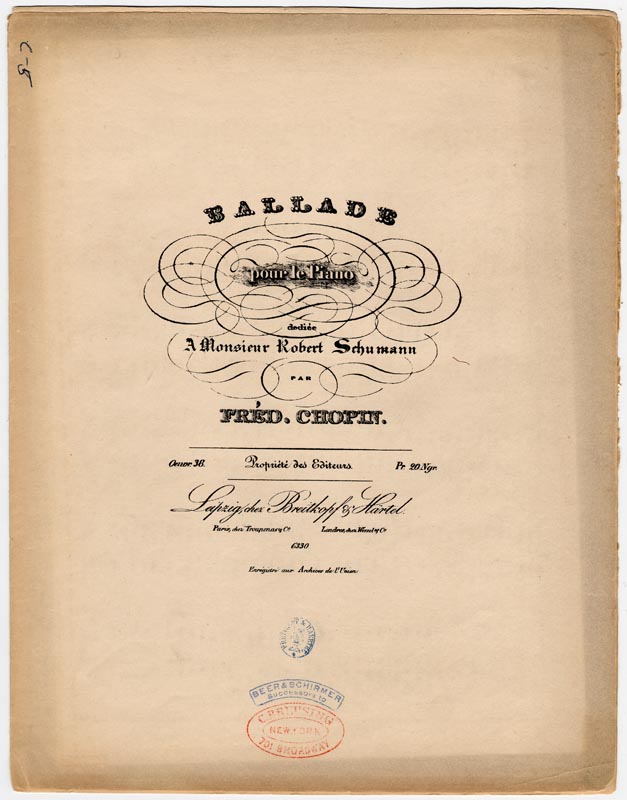Back to Chopin at 200 Home | Exhibit Gallery
Ballade pour le piano
No. 2, in F major
Op. 38
(Leipzig: Breitkopf & Hrtel, [1840])
From the library of Vladimir Horowitz
Gilmore Music Library

Chopin specialized in small forms such as the mazurka, the etude, the prelude, the nocturne, and the waltz. His longer works sometimes employed traditional genres like the sonata, but often his most ambitious ideas found expression in the polonaise, the fantasy, or the ballade. The ballade is perhaps the most personal of these genres, for Chopin may have been its inventor (if we discount the unrelated medieval genre of the same name). It is presumed to draw its inspiration from narrative poetry, although Chopin left us no explicit program for any of the ballades.
Over the course of his career, Chopin wrote four ballades, all of them major masterpieces. The Ballade No. 2, composed in 1839 and published in 1840, begins in F major but ends in A minor, a surprising tonal plan that has attracted much comment, although Jim Samson has noted precedents to Chopin’s scheme in the fantasies of Kalkbrenner and Hummel. Chopin dedicated this ballade to Robert Schumann. Chopin was not especially fond of Schumann’s music or his writings, but Schumann was an important critic, so his good opinion was valuable, and in any case he had dedicated Kreisleriana to Chopin in 1838, so it was appropriate to return the favor. Schumann had already been writing about Chopin for nearly a decade; his famous 1831 review of the Chopin’s variations on Mozart’s “Là ci darem la mano” is featured elsewhere in our exhibit. Schumann also reviewed many other works by Chopin; as Leon Plantinga has explained, he admired most of them, but not without reservations, which usually concerned Chopin’s preference for the smaller genres and what he regarded as an excessively uniform style. Such misgivings appear even in his review of the ballade dedicated to him. In this review, Schumann also reported having heard a private performance by the composer in 1836. At that time, he says, it ended in F major. He also noted that Chopin had mentioned a connection (in this piece and the first ballade as well) to the certain works by the Polish poet Adam Mickiewicz (1798–1855). Did Chopin play a different version of the piece for Schumann, or just an abbreviated one? Which Mickiewicz poems did he have in mind? These questions have fascinated scholars and critics for a century and a half, but after considerable research and an enormous outpouring of speculation, the answers remain uncertain.
Our copy of this ballade formerly belonged to the celebrated pianist Vladimir Horowitz (1903–1989), who bequeathed his personal papers and his library to Yale.
